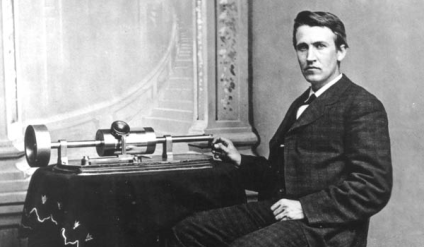Finally his parents consented to his new plan.
最終,愛迪生的父母同意了他的新計劃。
He began to sell fruit, peanuts, and papers on the train.
他開始在火車上售賣水果、花生和報紙。
When he was through with his duties, he set up a small laboratory in an empty express car of the train he traveled on.
當他完成自己的任務后,他在自己乘坐的一節空車廂上建立了一個小實驗室。
Here, if he wasn’t experimenting with strange liquids and powders, he was printing a little paper that he had started, called the “Weekly Herald.”
在這里,如果他沒有試驗奇怪的液體和粉末,那么他就在印刷一份他已經開業的小報《每周先驅報》。
It is not hard to imagine a young boy going through a train calling, “Papers — books — buy a book.”
不難想象這樣一個場景:一個男孩在車廂里叫賣“報紙,書籍,買一本書吧?!?/div>
But it is more difficult to picture him, alone in the empty car, printing some seven hundred copies of the little three-cent newspaper.
但難以想象的是,他一個人獨自在空車廂里,印刷大約七百份三美分的報紙。
A sudden swaying of the train one day jarred a piece of phosphorus from a shelf in the boy’s train laboratory, and the car took fire.
一天,火車突然晃動,愛迪生車廂實驗室架子上的磷塊發生碰撞,車廂著火了。
The conductor was furious at the thought of the danger young Al’s experimenting had caused;
列車長對年輕的愛迪生的實驗所導致的危險感到憤怒,
so he hurled the entire outfit, including the printing plant and the young inventor, off at the next station.
所以他在下一站將整個設備、包括印刷器械和年輕的愛迪生都扔下車。
 Edison’s inventions
Edison’s inventions
愛迪生的發明
The next step ahead for young Edison was an opportunity to learn telegraphy.
年輕的愛迪生下一步獲得了學習電報的機會。
He had saved the life of a railroad man’s little boy.
他救了鐵路人員家小男孩的性命。
The child had wandered onto the tracks, and young Edison had snatched him out of the way of the oncoming train.
這個小孩走到了鐵軌上,年輕的愛迪生把他拽到一邊,避開了駛來的火車。
The grateful father had no money to reward Edison; so he offered to teach him telegraphy.
小男孩的父親感激之余沒有錢獎勵愛迪生,于是提出教愛迪生發電報。
In a few days the boy had learned it, and had made a telegraph set of his own between his cellar and the house of one of his chums.
幾天后,愛迪生學會了發電報,還在自己的地下室和其中一個伙伴的房子之間制作了一套自己的電報機。
Edison’s inventions had begun!
愛迪生的發明生涯開始了!











